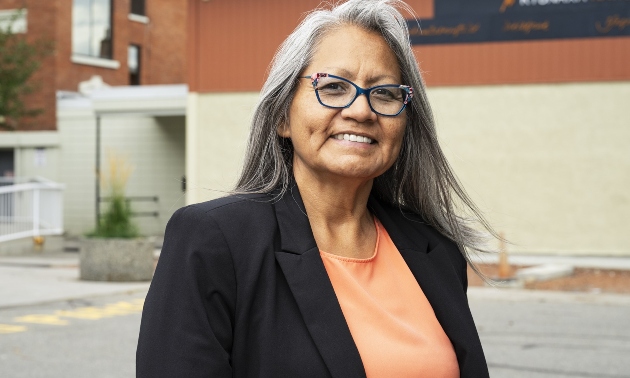Building connections: The Ktunaxa Regional Branding Initiative’s impact on Kootenay engagement

Janice Alpine is proud to share the accomplishments of the KRBI.Photo courtesy Janice Alpine
Janice Alpine shares some of the KRBI’s most notable achievements and goals, from tourism support to business development
The Ktunaxa Regional Branding Initiative (KRBI) has had a profound impact on business, cultural, and tourism sectors in the Kootenays. We had the opportunity to chat with Janice Alpine, the Business Development Officer of Tourism Engagement for the Ktunaxa Nation, to delve into the initiative's goals, collaborative endeavors, challenges faced, and notable achievements.
Alpine provided a comprehensive view of the KRBI's roles—from aligning with sustainable tourism practices to leveraging technology for broader outreach. We are thrilled to witness the initiative's evolution and aspirations for a lasting impact on the region.
Can you give us an overview of the Ktunaxa Regional Branding Initiative and its goals?
The initiative’s roles and objectives include:
-
Assisting in marketing the Kootenay region
-
Development and approval of a Ktunaxa regional brand attached to services and products created and manufactured by the Ktunaxa
-
Developing lasting relationships with other external resources in the region
-
Identifying and developing new business relationships with the Chambers in each town site
-
Ktunaxa buying in, supporting and assisting with promotion of the strategic branding plan
-
Promotional materials incorporating the Ktunaxa brand
-
More Ktunaxa artists and performers offering their product to visitors
-
Prioritization of primary stakeholders
- Identifying and prioritizing the primary stakeholders’ marketable products and services in the Ktunaxa strategic and branding plan
In your role as the Business Development Officer for Tourism Engagement, how do you collaborate with businesses and tourism centres?
It is my Tourism Engagement position that allows me to engage in this work throughout the region. We enter into a relationship with a business or organization to work together and discuss their needs and ideas, and work with them to develop the best method to move forward that follows the KRBI process.

- Kerry Shellborn photo
In your presentation to the City of Cranbrook, you mentioned that the business sector was looking to the Ktunaxa for products. What type of products are they seeking?
There really wasn’t a clear idea of what was required. We worked together to identify what was needed and came up with a plan on how to proceed. But we knew we wanted to ensure we answered the visitor's question, “is there a tribe here, and what did they use this land for?” (where the visitor is standing). I have actually developed a process covering a consistent message and ensuring we only use information we can share publically according to the archival information management system.
Are there specific challenges you have encountered in integrating the Ktunaxa story into the tourism and business sectors?
Yes, absolutely. The biggest challenge was ensuring a Western society (what I refer to them as) business/organization operator was wanted and we can work together. Coming from two very separate interpretations and societies takes patience to work though. I am happy to say we get through it and have created many long-lasting relationships.
What campaigns have been created through the KRBI to engage with the public and businesses in the region?
We created a three-video series that received two awards from the BCEDA in marketing Canada. The City of Cranbrook, Cranbrook Tourism, Fernie Tourism and Kimberley Tourism along with the Ktunaxa are very proud of it:
- Ski, hike and connect to the Ktunaxa Rockies
- Adventure through the Ktunaxa Hoodoos
- Recharge in the waters of Ktunaxa
The KRBI has also engaged in the Fernie Heritage Strategy, Cranbrook Tourism Strategy and helping Creston Museum to redesign the Ktunaxa display. All of that, we are very proud of. This has also allowed me to become visible in the region—I am part of the Cranbrook Tourism Board, Kootenay Rockies Tourism Board, Cranbrook Chamber Board, Crown of the Continent Board and Columbia River Treaty Heritage Steering Committee. All that has helped the Ktunaxa move KBRI forward.
What role does technology play in amplifying the reach and impact of the Ktunaxa story, especially in the digital age?
It helped us move the videos ahead, we are participating in a number of webpages from our stakeholders.
How do you see the initiative evolving in the future, and what aspirations do you have for its continued impact?
I really want it to create lasting legacies such as a centre, monuments or self-directed walking trails in all our larger centres, as well as signage for towns, at all entry ports of the region, and in BC Parks. I know this is a big ask, but I think I can see it happening.
How does the KRBI align with broader trends in sustainable and responsible tourism practices?
It’s an exact alignment. We are encouraging the Ktunaxa entrepreneurs and experience providers to engage in these projects as well as supporting the province’s strategic plan in encouraging and enhancing Indigenous tourism.
Learn more about how businesses can work with the Ktunaxa Nation, and their Economic and Investor Sector Mission.
